Electric Chain Hoists & Electric Motorized Chain Hoist Cranes
Types of electric chain hoists and motorized chain hoist cranes for sale 1 ton to 32 tons, ideal for diverse industrial lifting needs. Get your electric hoist.
Electric chain hoists are the unsung heroes of material handling, quietly powering countless industries with their reliability and efficiency. These versatile devices, often coupled with electric chain hoist cranes, play a pivotal role in lifting and moving heavy loads with ease. In this guide, we'll delve into the world of electric chain hoists and crane systems, exploring their importance, functionality, and diverse applications.
In the material handling, efficiency is the key. Electric chain hoists offer a streamlined solution for lifting and maneuvering heavy loads, enhancing productivity and reducing manual labor. Unlike traditional methods, such as manual hoisting or hydraulic systems, electric chain hoists provide consistent and controlled lifting capabilities, ensuring safety and precision in every operation. From manufacturing plants to construction sites, these hoists are indispensable tools for moving materials with speed and accuracy.
Overview of Electric Chain Hoist Cranes:
Electric chain hoist cranes serve as the backbone of numerous industrial operations, providing a versatile and adaptable means of lifting and transporting loads. These crane systems come in various configurations, including single girder, double girder, jib, and gantry cranes, each tailored to specific applications and environments. Whether it's loading and unloading cargo in a warehouse or positioning materials on a construction site, electric chain hoist cranes offer the flexibility and maneuverability needed to tackle diverse tasks efficiently.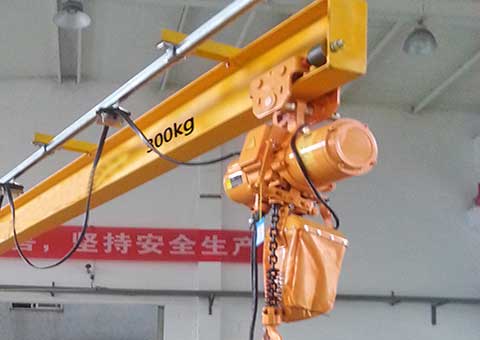
Electric chain hoist for sale 1 ton to 32 ton good price
Electric Chain Hoists: Advantages, and Safety
Electric chain hoists are compact, powerful devices designed to lift and lower heavy loads with precision and ease. Let's break down their key components and explore why they're essential tools in material handling.
Electric chain hoists consist of a sturdy metal housing containing an electric motor, gearbox, chain, and lifting hook. The electric motor provides the power necessary to drive the hoisting mechanism, while the gearbox ensures smooth and controlled movement. The chain, comprised of interconnected links, serves as the primary lifting mechanism, capable of supporting substantial weights. Finally, the lifting hook allows for secure attachment to the load, ensuring safe and reliable lifting operations.
Advantages Over Other Hoisting Mechanisms:
Electric chain hoists offer several distinct advantages over traditional hoisting mechanisms, such as manual chain hoists or hydraulic systems.
- Efficiency: Electric chain hoists are powered by electric motors, eliminating the need for manual labor and reducing operator fatigue. This results in faster and more efficient lifting operations, ultimately boosting productivity in material handling tasks.
- Precision: Electric chain hoists provide precise control over lifting and lowering speeds, allowing operators to position loads with accuracy and confidence. This level of control is especially critical in delicate or high-precision applications, where even minor deviations can have significant consequences.
- Safety: With built-in safety features such as overload protection and emergency stop capabilities, electric chain hoists prioritize operator safety. These devices are designed to minimize the risk of accidents and injuries, providing peace of mind in demanding work environments.
Safety Considerations and Regulations:
While electric chain hoists offer numerous benefits, it's crucial to prioritize safety in their operation. Here are some key safety considerations and regulations to keep in mind:
- Proper Training: Operators should receive comprehensive training on the safe use and operation of electric chain hoists. This includes understanding load capacities, operating controls, and emergency procedures.
- Regular Inspections: Routine inspections and maintenance are essential to ensure the continued safety and performance of electric chain hoists. Inspect chains, hooks, and other components for signs of wear or damage, and address any issues promptly.
- Compliance with Regulations: Electric chain hoists must comply with relevant safety regulations and standards, such as OSHA (Occupational Safety and Health Administration) guidelines. Ensure that hoists are properly rated for the intended load and environment.
By understanding the components, advantages, and safety considerations of electric chain hoists, operators can maximize efficiency while prioritizing safety in material handling operations. As we delve deeper into this topic, we'll explore specific types of electric chain hoists and their applications in various industries. Stay tuned for more insights on mastering electric chain hoists!
Main Types of Electric Chain Hoists and Specilized Electric Chain Hoists
Electric chain hoists are indispensable tools in material handling, offering versatility and efficiency across various industries. Let's delve into the main types of electric chain hoists and specialized variants designed for specific applications.
Electric chain hoists come in various types, each designed to meet specific lifting requirements and applications. The main types of electric chain hoists include: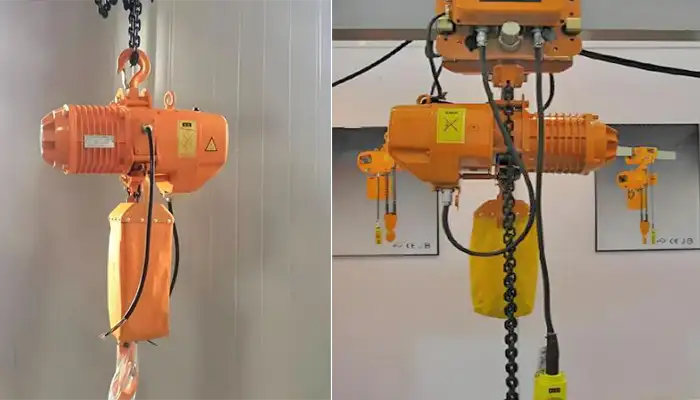
Hook mounted electric chain hoists and motorized travelling electric chain hoist
Stationary (Fixed) Electric Chain Hoists:
- Hook Mounted: These hoists are fixed in one location and use a hook for lifting. They are ideal for applications where the hoist doesn't need to move horizontally.
- Lug Mounted: Similar to hook-mounted, but they use a lug for a more permanent installation.
Portable (Suspension) Electric Chain Hoists:
- Push Trolley Mounted: These hoists can be manually moved along a beam using a push trolley, offering more flexibility in positioning.
- Geared Trolley Mounted: These are moved along a beam by a hand-operated chain, allowing for precise positioning.
- Motorized Trolley Mounted: These are equipped with a motor to move the hoist along a beam, providing ease of use and increased efficiency.
Low Headroom Electric Chain Hoists:
- Designed for environments with limited vertical space, these hoists have a compact design that maximizes the lifting height.
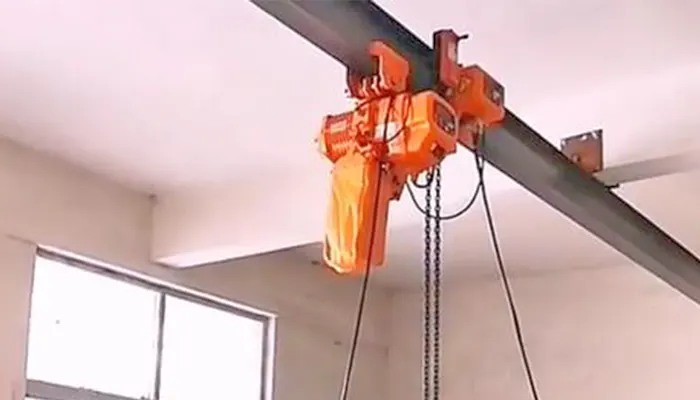
Low headroom electric chain hoist
Explosion-Proof Electric Chain Hoists:
Explosion-proof electric chain hoists are specifically designed to operate safely in hazardous environments where the presence of flammable gases, vapors, or dusts poses a risk of explosion. These hoists are engineered with several key features:
- Sealed Components: Explosion-proof hoists feature sealed motors, electrical enclosures, and control components to prevent the entry of flammable substances.
- Spark-Resistant Construction: Hoists are constructed with spark-resistant materials to minimize the risk of ignition in potentially explosive atmospheres.
- Compliance with Standards: Explosion-proof hoists comply with rigorous safety standards and regulations, such as ATEX or NEC classifications, ensuring they meet the requirements for hazardous area operation.
- Applications: Explosion-proof electric chain hoists are commonly used in industries such as oil and gas, chemical processing, pharmaceuticals, and food processing, where the presence of explosive substances necessitates stringent safety measures.
Clean Room Electric Chain Hoists:
Clean room electric chain hoists are designed for use in environments that require strict cleanliness and contamination control, such as pharmaceutical manufacturing, semiconductor production, or food processing facilities. These hoists incorporate features to prevent the introduction of contaminants into the controlled environment:
- Stainless Steel Construction: Clean room hoists are often constructed from stainless steel or other non-corrosive materials to withstand frequent cleaning and sterilization processes.
- Sealed Housings: Hoists feature sealed housings and enclosures to prevent the ingress of dust, particles, or other contaminants.
- Smooth Surfaces: Clean room hoists have smooth, crevice-free surfaces to facilitate easy cleaning and minimize the accumulation of debris.
- Applications: Clean room electric chain hoists are essential for lifting and positioning materials in sterile environments where even the slightest contamination can compromise product quality or safety.
Corrosion-Resistant Electric Chain Hoists:
Corrosion-resistant electric chain hoists are designed to withstand exposure to corrosive environments, such as marine, chemical processing, or wastewater treatment facilities. These hoists feature protective coatings and materials to prevent corrosion and extend service life:
- Protective Coatings: Hoists may be coated with specialized paints or finishes that provide resistance to corrosion from moisture, chemicals, or saltwater exposure.
- Stainless Steel Components: Critical components such as load chains, hooks, and fasteners may be constructed from stainless steel to resist corrosion in harsh environments.
- Sealed Bearings and Gears: Corrosion-resistant hoists may incorporate sealed bearings and gears to prevent the intrusion of moisture or contaminants.
- Applications: Corrosion-resistant electric chain hoists are essential for lifting operations in corrosive environments where standard hoists would quickly degrade, ensuring reliability and safety in challenging conditions.
High-Speed Electric Chain Hoists:
High-speed electric chain hoists are engineered for rapid lifting and lowering operations, offering increased productivity and efficiency in material handling tasks that require quick cycle times. These hoists feature several key characteristics:
- Enhanced Motor Performance: High-speed hoists are equipped with powerful motors capable of delivering fast lifting and lowering speeds.
- Optimized Gear Ratio: Hoists may have specialized gear ratios designed to maximize speed while maintaining load capacity and safety.
- Advanced Control Systems: High-speed hoists may feature advanced control systems that allow for precise speed adjustment and smooth acceleration and deceleration.
- Applications: High-speed electric chain hoists are commonly used in applications such as assembly lines, production processes, and manufacturing facilities where rapid material handling is essential to meet production targets and deadlines.
Variable Speed Electric Chain Hoists:
Variable speed electric chain hoists offer operators the flexibility to adjust lifting speeds according to the specific requirements of the task at hand. These hoists provide precise control over lifting operations, allowing for smooth acceleration, deceleration, and precise positioning of loads. Let's delve into the key features and applications of variable speed electric chain hoists:
Key Features:
- Adjustable Lifting Speeds: Variable speed electric chain hoists allow operators to select and adjust lifting speeds to suit the load and application, ranging from slow, precise movements to faster lifting and lowering speeds.
- Smooth Acceleration and Deceleration: Variable speed hoists are equipped with advanced control systems that ensure smooth acceleration and deceleration, minimizing jerky movements and reducing the risk of load sway or instability.
- Precise Positioning: The ability to vary lifting speeds enables operators to position loads with precision, even in confined or challenging spaces, ensuring accurate placement and minimizing the risk of damage to delicate or sensitive materials.
- Enhanced Safety Features: Variable speed hoists may incorporate additional safety features such as overload protection, anti-sway controls, and emergency stop functions to ensure safe and reliable operation in diverse lifting environments.
Applications:
- Delicate Material Handling: Variable speed electric chain hoists are ideal for lifting and positioning delicate or fragile materials that require careful handling, such as glass panels, electronic components, or precision machinery.
- Confined Spaces: The ability to adjust lifting speeds makes variable speed hoists suitable for operations in confined or congested spaces where precise maneuvering is essential, such as construction sites, workshops, or manufacturing facilities.
- Assembly and Production Lines: Variable speed hoists are commonly used in assembly and production lines where speed variability is necessary to accommodate different stages of the manufacturing process or to match the pace of automated machinery.
- High-Precision Applications: Variable speed hoists excel in applications that demand high levels of precision and control, such as positioning heavy machinery, aligning components during assembly, or installing equipment in tight or hard-to-reach spaces.
Overall, variable speed electric chain hoists offer versatility, precision, and safety, making them indispensable tools in a wide range of material handling applications. Whether it's lifting delicate materials, maneuvering in confined spaces, or ensuring precise positioning, variable speed hoists provide operators with the flexibility and control needed to optimize efficiency and productivity while prioritizing safety.
Comparison of Main Types of Electric Chain Hoists
Exploring Main Types of Electric Chain Hoists:
Electric chain hoists come in various configurations, each tailored to specific applications and operational requirements. Let's delve into the main types of electric chain hoists and understand their functionalities and advantages.
Single Speed vs. Dual Speed Hoists:
Single Speed Hoists:
- Single speed hoists operate at a constant lifting speed, making them suitable for straightforward lifting and lowering tasks.
- These hoists are cost-effective and straightforward to operate, making them ideal for applications where precise speed control is not a primary concern.
- Single speed hoists are commonly used in industries such as manufacturing, warehousing, and construction for general lifting purposes.
Dual Speed Hoists:
- Dual speed hoists offer the flexibility of two lifting speeds: a higher speed for rapid lifting and a lower speed for precise positioning.
- This versatility makes dual speed hoists ideal for applications that require both speed and precision, such as assembly lines or installations where careful placement is crucial.
- While dual speed hoists may have a higher initial cost than single speed hoists, their ability to accommodate various lifting scenarios can result in increased efficiency and productivity.
Fixed vs. Variable Speed Hoists:
Fixed Speed Hoists:
- Fixed speed hoists operate at a predetermined lifting speed, which remains constant throughout the lifting process.
- These hoists are suitable for applications where a consistent lifting speed is sufficient, such as routine material handling tasks or repetitive lifting operations.
- Fixed speed hoists are straightforward to operate and maintain, making them a practical choice for environments where simplicity is valued.
Variable Speed Hoists:
- Variable speed hoists allow operators to adjust the lifting speed according to the specific requirements of the task.
- This flexibility makes variable speed hoists well-suited for applications that demand precise control over lifting speeds, such as delicate material handling or operations in confined spaces.
- While variable speed hoists may require additional training for operators and regular maintenance to ensure optimal performance, their ability to adapt to various lifting scenarios can enhance efficiency and safety.
Low Headroom vs. Standard Headroom Hoists:
Low Headroom Hoists:
- Low headroom hoists are designed with a compact profile, allowing them to operate in environments with limited vertical clearance.
- These hoists are ideal for installations where space constraints or overhead obstructions pose challenges, such as low-ceiling warehouses or confined work areas.
- Low headroom hoists offer the same lifting capabilities as standard hoists but with a reduced overall height, making them a practical solution for maximizing vertical space utilization.
Standard Headroom Hoists:
- Standard headroom hoists feature a traditional design with ample vertical clearance between the load and the hoisting mechanism.
- These hoists are suitable for applications where vertical space is not a limiting factor, such as open work environments or installations with high ceilings.
- Standard headroom hoists offer straightforward installation and operation, making them a versatile choice for a wide range of material handling tasks.
By understanding the main types of electric chain hoists and their respective advantages, operators can select the most suitable hoist for their specific needs. Whether it's optimizing speed and precision or accommodating space constraints, there's a hoist configuration available to meet virtually any lifting requirement. In the following sections, we'll explore the applications of electric chain hoists across various industries and delve deeper into best practices for selecting and operating these essential lifting devices.
Types of Electric Chain Hoist Cranes
Electric chain hoist cranes are essential tools for lifting and transporting heavy loads in various industries. Understanding the different types of electric chain hoist cranes is crucial for selecting the right crane configuration to meet specific material handling requirements. Let's explore the main types of electric chain hoist cranes in more detail:
Overhead electric chain hoist cranes are essential for lifting and moving heavy loads in various industrial and commercial settings. These cranes are designed to provide efficient material handling solutions while maximizing space utilization and productivity. Let's explore the main types of overhead electric chain hoist cranes:
Overhead Electric Chain Hoists Cranes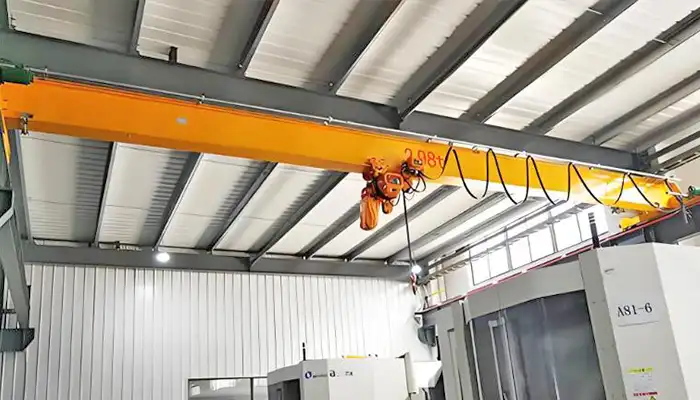
Single Girder Cranes:
- Single girder cranes feature a single bridge beam supported by end trucks on either side of the runway.
- These cranes are known for their compact design, lightweight construction, and cost-effectiveness.
- Single girder cranes are suitable for light to moderate lifting applications and are commonly used in warehouses, workshops, and manufacturing facilities.
- They offer efficient material handling solutions for tasks such as loading/unloading, assembly, and maintenance operations.
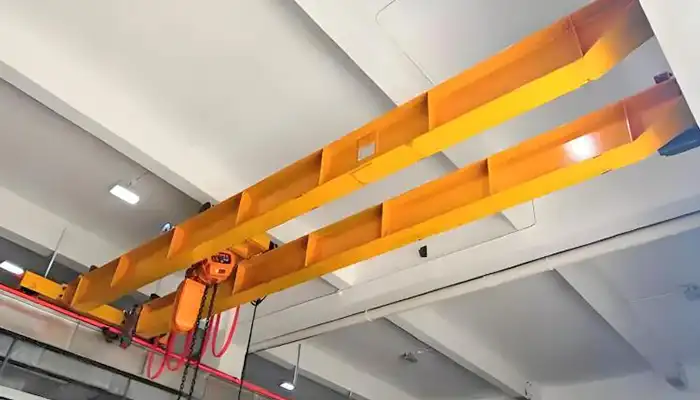
Double Girder Cranes:
- Double girder cranes are characterized by two bridge beams (girders) supported by end trucks, providing increased stability and load capacity compared to single girder cranes.
- These cranes are suitable for heavy-duty lifting applications requiring higher capacities and longer spans.
- Double girder cranes offer enhanced versatility and can accommodate larger loads, making them ideal for industries such as steel fabrication, shipbuilding, and heavy manufacturing.
- They provide reliable and robust solutions for lifting and transporting heavy machinery, equipment, and materials in demanding environments.
Jib Cranes with Electric Chain Hoists:
Jib cranes equipped with electric chain hoists provide versatile and efficient solutions for localized material handling tasks. These cranes offer precise control and maneuverability, making them ideal for lifting and positioning loads in confined spaces or specific work areas. Let's explore the different configurations of jib cranes with electric chain hoists:
Wall-Mounted Electric Chain Hoist Crane:
- Wall-mounted jib cranes feature a horizontal boom (jib) that is securely attached to a vertical wall or structure.
- These cranes are ideal for applications where floor space is limited, as they do not require a dedicated floor-mounted support structure.
- Wall-mounted jib cranes with electric chain hoists provide efficient lifting and material handling solutions for tasks such as loading/unloading trucks, moving materials between workstations, and positioning loads in tight spaces.
- They offer precise control and maneuverability, allowing operators to lift and position loads with ease and accuracy.
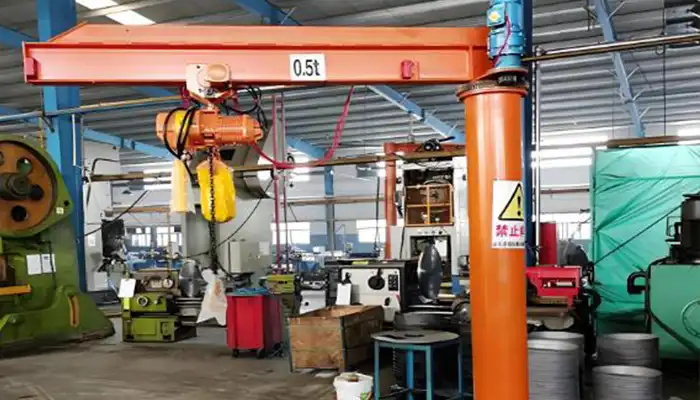
Pillar-Mounted Electric Chain Hoist Crane:
- Pillar-mounted jib cranes feature a vertical mast (pillar) that is securely anchored to the floor, with a horizontal boom (jib) extending outward.
- These cranes provide stability and support for lifting and moving heavy loads within a specific area or work zone.
- Pillar-mounted jib cranes with electric chain hoists are commonly used in manufacturing facilities, workshops, and warehouses for tasks such as assembly, maintenance, and material handling.
- They offer versatility and flexibility, allowing operators to lift and position loads with precision while minimizing the risk of collisions or obstructions.
Portable Electric Chain Hoist Jib Cranes:
- Portable jib cranes with electric chain hoists feature a compact and lightweight design, allowing for easy transport and installation in various locations.
- These cranes are mounted on a wheeled base or cart, providing mobility and flexibility for lifting and material handling tasks in different work areas.
- Portable jib cranes with electric chain hoists are ideal for applications where a permanent crane installation is not feasible or where flexibility is required to adapt to changing work environments.
- They offer the convenience of on-demand lifting capabilities, allowing operators to quickly set up and use the crane as needed for lifting and positioning loads.
Jib cranes with electric chain hoists offer efficient and ergonomic solutions for lifting and material handling tasks in diverse industries and applications. Whether it's maximizing floor space, improving productivity, or enhancing safety, these cranes provide reliable performance and versatility for a wide range of material handling needs.
Gantry Cranes with Electric Chain Hoists:
Gantry cranes equipped with electric chain hoists provide versatile and efficient solutions for lifting and moving heavy loads in various environments. These cranes offer mobility, stability, and precise control, making them suitable for a wide range of material handling applications. Let's explore the different configurations of gantry cranes with electric chain hoists:
Full Gantry Crane with Electric Chain Hoists:
- Full gantry cranes feature two parallel runways supported by legs or columns, allowing for movement along both the length and width of the crane.
- These cranes offer stability and support for lifting and transporting heavy loads across a wide area or work zone.
- Full gantry cranes with electric chain hoists are commonly used in manufacturing facilities, construction sites, and shipping yards for tasks such as loading/unloading, assembly, and material handling.
- They provide versatility and flexibility, allowing operators to lift and position loads with precision while maximizing productivity and efficiency.
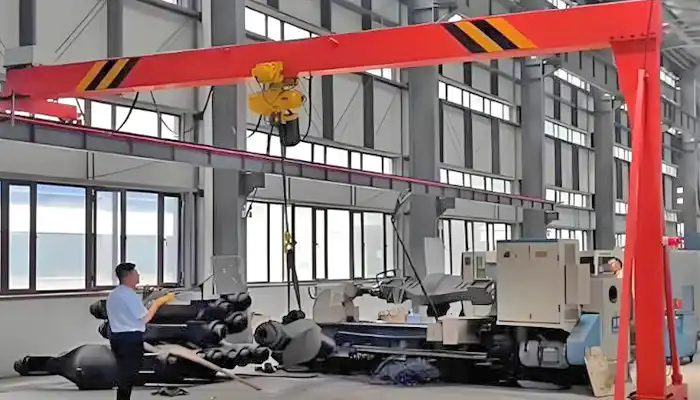
Semi Gantry Crane with Electric Chain Hoists:
- Semi gantry cranes feature one end supported by a wall or structure, with the other end supported by legs or columns.
- These cranes offer stability and support similar to full gantry cranes but are designed for applications where space constraints or specific layout requirements dictate a partial gantry configuration.
- Semi gantry cranes with electric chain hoists are ideal for tasks such as loading/unloading trucks, moving materials between workstations, and positioning loads in confined spaces.
- They provide efficient material handling solutions while minimizing the footprint and impact on the surrounding environment.
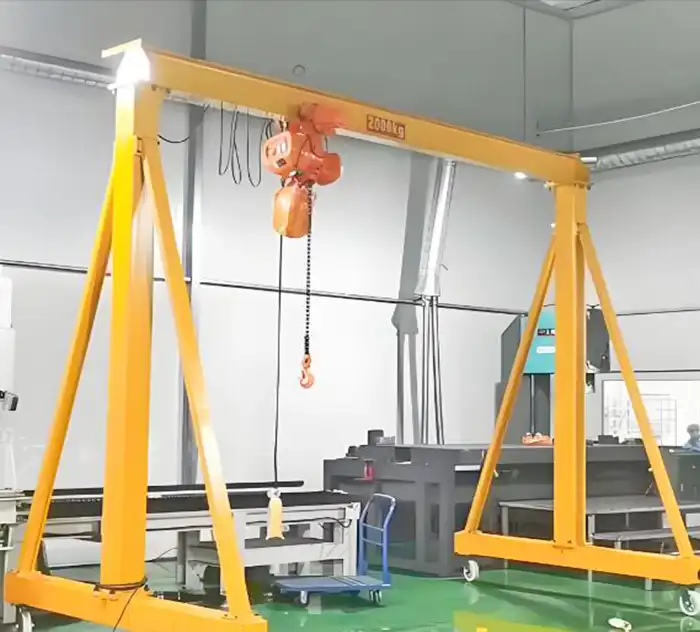
Portable Electric Chain Hoist Gantry Crane:
- Portable gantry cranes with electric chain hoists feature a lightweight and modular design, allowing for easy transport and assembly in various locations.
- These cranes are mounted on wheels or casters, providing mobility and flexibility for lifting and material handling tasks in different work areas.
- Portable gantry cranes with electric chain hoists are ideal for applications where a permanent crane installation is not feasible or where flexibility is required to adapt to changing work environments.
- They offer the convenience of on-demand lifting capabilities, allowing operators to quickly set up and use the crane as needed for lifting and positioning loads.
Gantry cranes with electric chain hoists offer efficient and reliable solutions for lifting and material handling tasks in diverse industries and applications. Whether it's maximizing space utilization, improving productivity, or enhancing safety, these cranes provide versatile performance to meet a wide range of material handling needs.
Differences in Design and Functionality:
Electric chain hoist cranes come in various designs, each offering unique features and capabilities to meet specific material handling needs. Understanding the differences in design and functionality is essential for selecting the most suitable crane for a particular application. Let's explore the key factors that differentiate electric chain hoist cranes:
Load Capacity and Span:
- Load Capacity: One of the primary considerations when selecting an electric chain hoist crane is its load capacity, which refers to the maximum weight the crane can safely lift and transport. Single girder cranes typically have lower load capacities compared to double girder cranes due to their lighter construction. The load capacity of a crane is determined by factors such as the strength of its structural components, hoisting mechanism, and supporting infrastructure.
- Span: The span of a crane refers to the distance between the runway rails or support structures. Double girder cranes typically have longer spans compared to single girder cranes, allowing them to cover larger areas and handle heavier loads. The span of a crane is determined by factors such as the size of the facility, the layout of the work area, and the material handling requirements.
Mobility and Versatility:
- Mobility: The mobility of an electric chain hoist crane refers to its ability to move along the length of the runway or across the work area. Single girder cranes are often more mobile than double girder cranes, as they have a lighter and more compact design. Jib cranes and gantry cranes offer even greater mobility, allowing for movement in multiple directions and locations within a facility.
- Versatility: Electric chain hoist cranes vary in their versatility and adaptability to different material handling tasks. Single girder cranes are suitable for a wide range of applications but may have limitations in terms of load capacity and span. Double girder cranes offer higher load capacities and longer spans, making them suitable for heavy-duty lifting operations. Jib cranes and gantry cranes are highly versatile and can be configured to meet specific material handling requirements, such as lifting and rotating loads or operating in confined spaces.
Installation Requirements:
- Installation requirements for electric chain hoist cranes depend on factors such as the type of crane, the layout of the facility, and the existing infrastructure. Single girder cranes typically have simpler installation requirements compared to double girder cranes, as they require fewer structural supports and less overhead clearance. Jib cranes and gantry cranes may require specialized foundations or support structures to ensure stability and safety during operation. Factors such as floor space, ceiling height, and access to power sources also influence the installation of electric chain hoist cranes.
- The differences in design and functionality of electric chain hoist cranes allows operators to select the most appropriate crane configuration for their specific material handling requirements. Whether it's optimizing load capacity, maximizing mobility, or ensuring seamless installation, electric chain hoist cranes offer versatile solutions for lifting and transporting heavy loads in diverse industries and applications.
Applications of Electric Chain Hoists in Various Industries:
Electric chain hoists are versatile tools that find applications across diverse industries, providing efficient and reliable solutions for lifting and material handling tasks. Let's explore how electric chain hoists are utilized in different sectors:
Manufacturing and Production:
- Assembly Line Operations: Electric chain hoists are used for lifting and positioning components during assembly processes, improving efficiency and productivity.
- Material Handling: Hoists assist in the movement of raw materials, work-in-progress, and finished products within manufacturing facilities, optimizing workflow and reducing manual labor.
Construction and Building:
- Material Handling: Electric chain hoists facilitate the lifting and positioning of heavy construction materials such as steel beams, concrete panels, and prefabricated structures at construction sites.
- Installation: Hoists are used to hoist and install machinery, HVAC units, and building components during construction and renovation projects, ensuring precision and safety.
Warehousing and Distribution:
- Stock Handling: Electric chain hoists aid in the loading and unloading of palletized goods, equipment, and supplies in warehouses and distribution centers, streamlining logistics operations.
- Order Picking: Hoists assist in retrieving and transporting items from high shelves or storage racks, improving order fulfillment efficiency and reducing manual handling risks.
Automotive and Aerospace:
- Manufacturing: Electric chain hoists are employed in automotive and aerospace manufacturing facilities for lifting and positioning vehicle components, aircraft parts, and engine assemblies during production processes.
- Maintenance: Hoists support maintenance and repair operations by lifting and lowering heavy machinery, vehicles, and aircraft components for inspection, servicing, and repairs.
Entertainment and Stage Rigging:
- Stage Setup: Electric chain hoists play a crucial role in stage rigging for theaters, concert venues, and event spaces, lifting and suspending lighting rigs, sound equipment, and stage props.
- Set Construction: Hoists assist in the construction and installation of stage sets, backdrops, and scenery elements, enabling rapid assembly and customization for live performances and events.
Electric chain hoists offer precise control, reliability, and safety features that make them indispensable in various industries and applications. Whether it's lifting heavy loads in manufacturing facilities, assisting construction projects, optimizing warehouse operations, supporting aerospace manufacturing, or facilitating stage productions, electric chain hoists provide efficient and versatile solutions for diverse material handling needs.
Choosing the Right Electric Chain Hoist for Your Crane:
Selecting the appropriate electric chain hoist for your crane is essential to ensure optimal performance, safety, and efficiency in material handling operations. Let's explore the key factors to consider when choosing an electric chain hoist for your crane:
Understanding Crane Specifications:
- Before selecting an electric chain hoist, it's crucial to understand the specifications of your crane, including its load capacity, span, and lifting height.
- Consider the type of crane (e.g., single girder, double girder, jib, or gantry) and its structural design to determine compatibility with different hoist configurations.
Matching Hoist Capacity with Crane Requirements:
- Ensure that the capacity of the electric chain hoist matches the lifting capacity of the crane to avoid overloading or underutilizing the equipment.
- Consider factors such as the weight of the heaviest loads to be lifted, load distribution, and any additional equipment or attachments that may affect the hoist's performance.
Considering Environmental Factors:
- Evaluate the environmental conditions in which the crane will operate, including temperature extremes, humidity levels, and exposure to corrosive substances or hazardous materials.
- Choose an electric chain hoist with appropriate protective features such as corrosion-resistant coatings, sealed components, or explosion-proof enclosures to ensure durability and safety in challenging environments.
Evaluating Cost vs. Performance:
- Compare the initial cost of the electric chain hoist with its long-term performance, reliability, and maintenance requirements.
- Consider factors such as load capacity, lifting speed, duty cycle, and safety features to determine the overall value and return on investment (ROI) of the hoist.
- Balance cost considerations with the need for quality, reliability, and compliance with industry standards and regulations to ensure the safety and productivity of your material handling operations.
By carefully considering crane specifications, matching hoist capacity with crane requirements, evaluating environmental factors, and balancing cost vs. performance, you can choose the right electric chain hoist for your crane to meet your material handling needs effectively and efficiently. Investing in the appropriate hoisting equipment ensures safe and reliable lifting operations while maximizing productivity and minimizing downtime in your facility.
Installation and Maintenance Best Practices:
Proper installation and regular maintenance are essential to ensure the safe and efficient operation of electric chain hoists. Implementing best practices in installation and maintenance helps prolong the lifespan of the equipment, minimize downtime, and prevent accidents. Let's explore key considerations for installation and maintenance:
Pre-Installation Planning:
- Conduct a thorough assessment of the installation site, including structural integrity, overhead clearances, and electrical requirements.
- Ensure compliance with local regulations, building codes, and safety standards governing the installation of electric chain hoists.
- Coordinate with qualified professionals, including structural engineers, electricians, and crane technicians, to ensure proper installation and integration with existing infrastructure.
Safety Protocols during Installation:
- Prioritize safety during the installation process by following manufacturer guidelines and safety protocols.
- Use appropriate personal protective equipment (PPE), such as hard hats, safety goggles, and gloves, when handling hoisting equipment and performing installation tasks.
- Securely anchor the hoist and crane components to structural supports or mounting surfaces to prevent movement or instability during operation.
- Verify proper alignment, levelness, and clearances to ensure safe and efficient hoist operation.
Routine Inspection and Maintenance Procedures:
- Establish a routine inspection and maintenance schedule based on manufacturer recommendations and industry best practices.
- Conduct visual inspections of hoist components, including chains, hooks, brakes, and electrical connections, for signs of wear, damage, or corrosion.
- Perform functional tests of hoist controls, brakes, limit switches, and safety features to verify proper operation and compliance with safety standards.
- Lubricate moving parts, such as chains, gears, and bearings, according to manufacturer specifications to minimize friction and prevent premature wear.
Troubleshooting Common Issues:
- Train personnel in troubleshooting techniques to identify and address common issues that may arise during hoist operation.
- Maintain detailed records of maintenance activities, inspection findings, and any repairs or adjustments made to the hoist system.
- Address issues promptly to prevent equipment downtime and mitigate safety risks associated with malfunctioning hoists.
- Consult with qualified technicians or service providers for complex repairs or troubleshooting tasks beyond the scope of routine maintenance.
By adhering to pre-installation planning, safety protocols, routine inspection, and maintenance procedures, as well as developing troubleshooting capabilities, you can ensure the safe and reliable operation of electric chain hoists in your facility. Prioritizing safety and proactive maintenance practices not only protect personnel and equipment but also optimize performance and productivity in material handling operations.
Case Studies and Real-world Examples:
Real-world examples and case studies provide valuable insights into the successful implementation of electric chain hoists across different industries, highlighting challenges faced, solutions implemented, and lessons learned from experience. Let's explore some case studies:
Successful Implementations in Different Industries:
- Manufacturing Sector: A multinational automotive manufacturer implemented electric chain hoists in its production facility to streamline material handling processes. By integrating hoists with assembly line operations, the company achieved significant improvements in efficiency, productivity, and worker safety.
- Construction Industry: A leading construction firm utilized electric chain hoists for lifting and positioning heavy building materials during the construction of a high-rise building. The hoists enabled precise control and maneuverability, facilitating timely completion of construction tasks while ensuring compliance with safety regulations.
- Warehousing and Distribution: A large logistics company deployed electric chain hoists in its distribution centers to optimize warehouse operations. The hoists facilitated the efficient loading and unloading of palletized goods, improving throughput and reducing labor costs in the logistics supply chain.
- 4. Entertainment Sector: A renowned theater production company utilized electric chain hoists for stage rigging and set construction in theatrical productions. The hoists provided reliable lifting capabilities for suspending lighting rigs, sound equipment, and stage props, enhancing the visual and technical aspects of live performances.
Challenges Faced and Solutions Implemented:
- Limited Space: In a manufacturing facility with restricted floor space, the challenge was to install electric chain hoists without obstructing workflow or compromising safety. The solution involved customizing the hoist mounting configurations and optimizing crane layouts to maximize space utilization while ensuring safe operation.
- Heavy Load Handling: In construction projects requiring the lifting and positioning of oversized or irregularly shaped loads, the challenge was to ensure stability and control during hoisting operations. The solution involved using specialized rigging techniques, such as spreader bars or lifting beams, to evenly distribute the load and minimize the risk of accidents or equipment damage.
- Environmental Conditions: In outdoor construction sites or harsh industrial environments with exposure to extreme temperatures, moisture, or corrosive substances, the challenge was to protect electric chain hoists from environmental damage. The solution involved selecting hoists with durable construction and corrosion-resistant coatings, as well as implementing preventive maintenance measures to mitigate the effects of environmental factors.
Lessons Learned from Experience:
- Prioritize Safety: Safety should always be the top priority when implementing electric chain hoists in industrial settings. Investing in proper training, equipment maintenance, and adherence to safety protocols helps prevent accidents and ensures the well-being of personnel.
- Collaboration is Key: Successful hoist implementations often require collaboration between stakeholders, including engineers, technicians, and end-users. Effective communication and teamwork facilitate the identification of requirements, selection of appropriate equipment, and implementation of solutions tailored to specific needs.
- Continuous Improvement: Regular evaluation and feedback are essential for continuous improvement in hoist operations. By monitoring performance metrics, identifying areas for optimization, and implementing best practices, organizations can enhance efficiency, reliability, and safety in material handling processes over time.
By studying real-world examples and case studies, organizations can gain valuable insights into the successful implementation of electric chain hoists, anticipate challenges, and leverage lessons learned to optimize performance and achieve operational excellence in their respective industries.
Conclusion:
In conclusion, electric chain hoists play a crucial role in various industries, offering efficient and reliable solutions for lifting and material handling tasks. Throughout this guide, we've explored the main types of electric chain hoists, their applications in different industries, installation and maintenance best practices, and real-world examples of successful implementations. Let's recap the key points and provide final recommendations for users:
Recap of Key Points:
- Electric chain hoists come in various types, including standard, specialized, and variable speed hoists, each designed to meet specific lifting requirements.
- Electric chain hoists are utilized in diverse industries such as manufacturing, construction, warehousing, automotive, aerospace, and entertainment, providing efficient material handling solutions.
- Proper installation, routine inspection, and maintenance are essential to ensure the safe and reliable operation of electric chain hoists, while adherence to safety protocols and regulations is paramount to protect personnel and equipment.
- Real-world examples and case studies highlight successful implementations of electric chain hoists, showcasing their versatility, performance, and impact on operational efficiency.
Final Recommendations for Users:
- Prioritize safety at all times by following manufacturer guidelines, conducting regular inspections, and providing proper training for personnel involved in hoist operations.
- Select the appropriate electric chain hoist based on crane specifications, load requirements, environmental conditions, and performance considerations to ensure optimal performance and longevity.
- Invest in preventive maintenance and proactive troubleshooting to address issues promptly and minimize downtime, thereby maximizing productivity and reducing operational costs.
- Collaborate with qualified professionals and industry experts to leverage their expertise and experience in selecting, installing, and maintaining electric chain hoists tailored to your specific application needs.
Encouragement for Further Exploration and Learning:
- Continue to explore and stay informed about advancements in electric chain hoist technology, industry best practices, and safety standards to enhance your knowledge and skills in material handling operations.
- Engage with industry associations, attend seminars, and participate in training programs to broaden your understanding of electric chain hoists and related equipment, fostering continuous improvement and professional development.
- Share your experiences, challenges, and lessons learned with peers and colleagues to contribute to the collective knowledge and promote collaboration within the material handling community.
In conclusion, electric chain hoists are indispensable tools that offer versatile, efficient, and safe solutions for lifting and material handling across various industries. By understanding their capabilities, implementing best practices, and fostering a culture of continuous improvement, users can harness the full potential of electric chain hoists to optimize productivity, enhance safety, and drive success in their operations.




